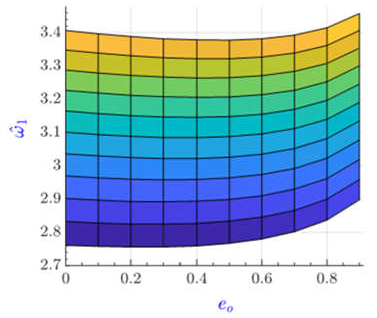Analytical solution for free vibration analysis of GPL-RP beam integrated with piezoelectric layers
Author affiliations
DOI:
https://doi.org/10.15625/0866-7136/17912Keywords:
piezoelectric material, porous beam, graphene platelets, Navier's solutionAbstract
This report presents an analytical approach to the natural frequency analysis of a porous beam consisting of a host porous layer reinforced with graphene platelets (GPLs), namely GPL-reinforced porous core, and two piezoelectric outer layers. In the modelling, symmetric distributions of both porosity and GPLs in the core are supposed. The effective mechanical properties of the GPL-reinforced porous core are estimated by Halpin–Tsai model and the rule of mixture. The electric potential in each piezoelectric layer is assumed to vary linearly across its thickness. Two types of electrical boundary conditions, which are open- and closed-circuits, are considered for the free surfaces of the piezoelectric layers. Parabolic shear deformation beam theory associated with Hamilton’s principle is adopted to derive the governing equations of the free vibration. Afterwards these equations are solved analytically by Navier’s solution. Comparative and comprehensive studies are carried out to examine the accuracy and effects of parameters and conditions, such as GPL weight fraction, porosity coefficient, and electrical boundary conditions on the natural frequencies of the beam.
Downloads
References
M. R. Barati and A. M. Zenkour. Analysis of postbuckling of graded porous GPL-reinforced beams with geometrical imperfection. Mechanics of Advanced Materials and Structures, 26, (2018), pp. 503–511.
M. R. Barati and A. M. Zenkour. Post-buckling analysis of refined shear deformable graphene platelet reinforced beams with porosities and geometrical imperfection. Composite Structures, 181, (2017), pp. 194–202.
M. Ganapathi, B. Anirudh, C. Anant, and O. Polit. Dynamic characteristics of functionally graded graphene reinforced porous nanocomposite curved beams based on trigonometric shear deformation theory with thickness stretch effect. Mechanics of Advanced Materials and Structures, 28, (2019), pp. 741–752.
K. Gao, D. M. Do, R. Li, S. Kitipornchai, and J. Yang. Probabilistic stability analysis of functionally graded graphene reinforced porous beams. Aerospace Science and Technology, 98, (2020).
S. Sahmani, M. M. Aghdam, and T. Rabczuk. Nonlinear bending of functionally graded porous micro/nano-beams reinforced with graphene platelets based upon nonlocal strain gradient theory. Composite Structures, 186, (2018), pp. 68–78.
B. Anirudh, M. Ganapathi, C. Anant, and O. Polit. A comprehensive analysis of porous graphene-reinforced curved beams by finite element approach using higher-order structural theory: Bending, vibration and buckling. Composite Structures, 222, (2019).
S. Kitipornchai, D. Chen, and J. Yang. Free vibration and elastic buckling of functionally graded porous beams reinforced by graphene platelets. Materials & Design, 116, (2017), pp. 656–665.
R. Priyanka, C. M. Twinkle, and J. Pitchaimani. Stability and dynamic behavior of porous FGM beam: influence of graded porosity, graphene platelets, and axially varying loads. Engineering with Computers, 38, (2021), pp. 4347–4366.
H. Xu, Y. Q. Wang, and Y. Zhang. Free vibration of functionally graded graphene plateletreinforced porous beams with spinning movement via differential transformation method. Archive of Applied Mechanics, 91, (2021), pp. 4817–4834.
F. Kiarasi, M. Babaei, P. Sarvi, K. Asemi, M. Hosseini, and M. Omidi Bidgoli. A review on functionally graded porous structures reinforced by graphene platelets. Journal of Computational Applied Mechanics, 52, (4), (2021), pp. 731–750.
S. Zhao, Z. Zhao, Z. Yang, L. Ke, S. Kitipornchai, and J. Yang. Functionally graded graphene reinforced composite structures: A review. Engineering Structures, 210, (2020),
N. V. Nguyen, J. Lee, and H. Nguyen-Xuan. Active vibration control of GPLs-reinforced FG metal foam plates with piezoelectric sensor and actuator layers. Composites Part B: Engineering, 172, (2019), pp. 769–784.
L. B. Nguyen, N. V. Nguyen, C. H. Thai, A. M. J. Ferreira, and H. Nguyen-Xuan. An isogeometric B´ezier finite element analysis for piezoelectric FG porous plates reinforced by graphene platelets. Composite Structures, 214, (2019), pp. 227–245.
N. V. Nguyen, L. B. Nguyen, H. Nguyen-Xuan, and J. Lee. Analysis and active control of geometrically nonlinear responses of smart FG porous plates with graphene nanoplatelets reinforcement based on bézier extraction of NURBS. International Journal of Mechanical Sciences, 180, (2020).
Y. X. Hao, H. Li, W. Zhang, X. S. Ge, S. W. Yang, and Y. T. Cao. Active vibration control of smart porous conical shell with elastic boundary under impact loadings using GDQM and IQM. Thin-Walled Structures, 175, (2022).
S. C. Tjong. Recent progress in the development and properties of novel metal matrix nanocomposites reinforced with carbon nanotubes and graphene nanosheets. Materials Science and Engineering: R: Reports, 74, (2013), pp. 281–350.
T. R. C. Chuaqui and C. M. C. Roque. Analysis of functionally graded piezoelectric Timoshenko smart beams using a multiquadric radial basis function method. Composite Structures, 176, (2017), pp. 640–653.
Y. Kiani. Free vibration of functionally graded carbon nanotube reinforced composite plates integrated with piezoelectric layers. Computers & Mathematics with Applications, 72, (2016), pp. 2433–2449.
B. A. Selim, L.W. Zhang, and K. M. Liew. Active vibration control of FGM plates with piezoelectric layers based on Reddy’s higher-order shear deformation theory. Composite Structures, 155, (2016), pp. 118–134.
J. Tian, Q. Guo, and G. Shi. Laminated piezoelectric beam element for dynamic analysis of piezolaminated smart beams and GA-based LQR active vibration control. Composite Structures, 252, (2020).
P. Phung-Van, T. Nguyen-Thoi, T. Le-Dinh, and H. Nguyen-Xuan. Static and free vibration analyses and dynamic control of composite plates integrated with piezoelectric sensors and actuators by the cell-based smoothed discrete shear gap method (CS-FEM-DSG3). Smart Materials and Structures, 22, (2013).

Downloads
Published
How to Cite
License

This work is licensed under a Creative Commons Attribution-ShareAlike 4.0 International License.
Funding data
-
Đại học Đà Nẵng
Grant numbers B2022-DN02-08









